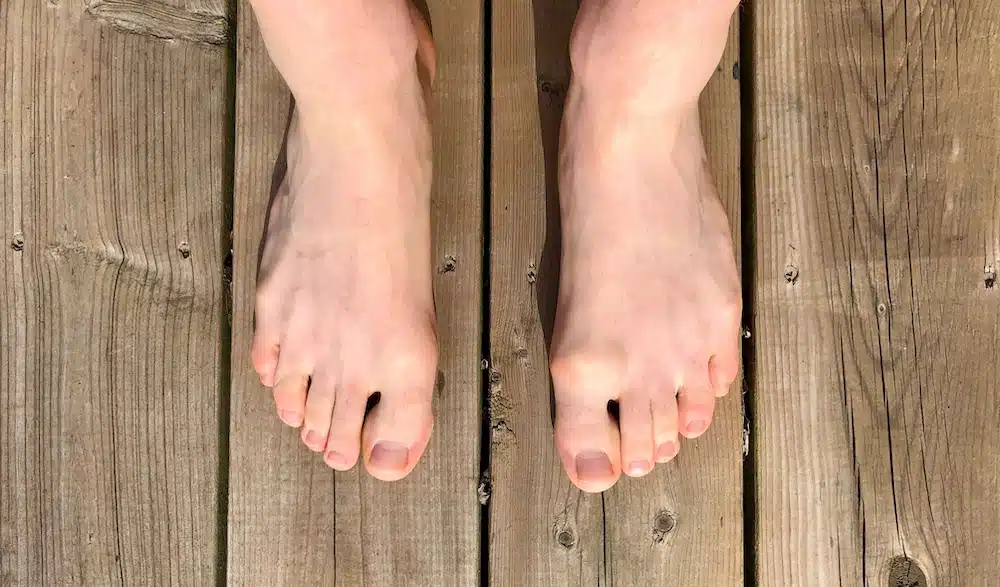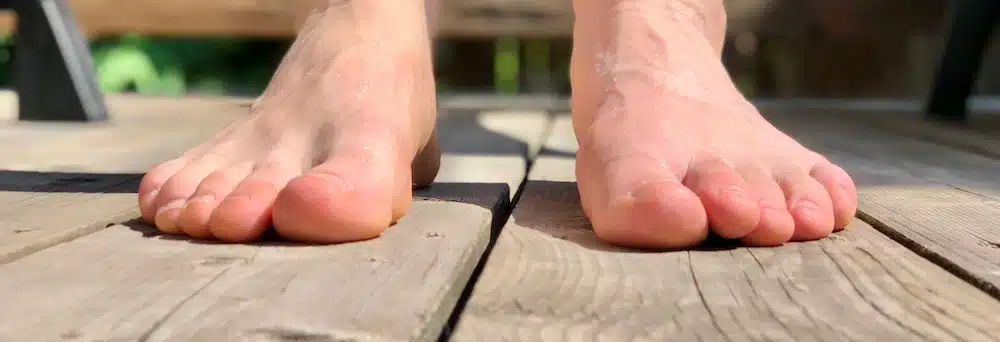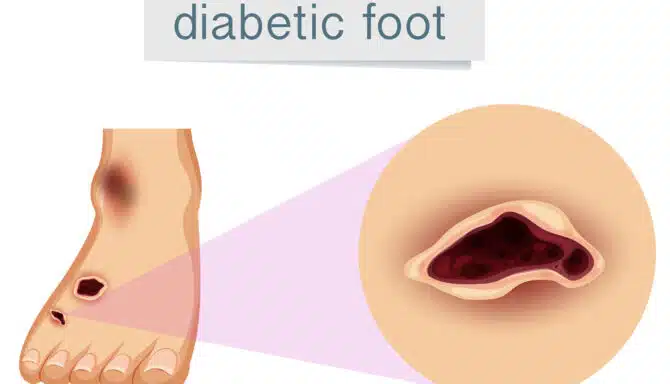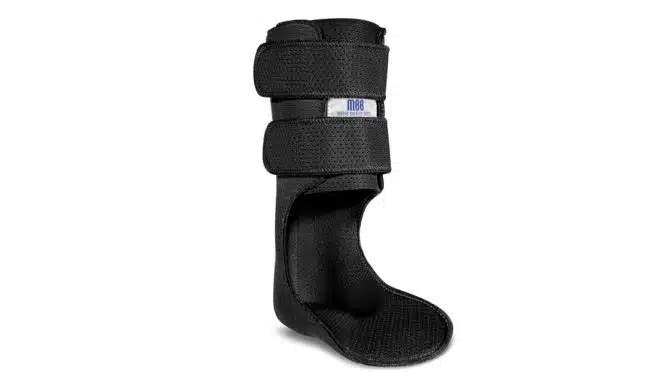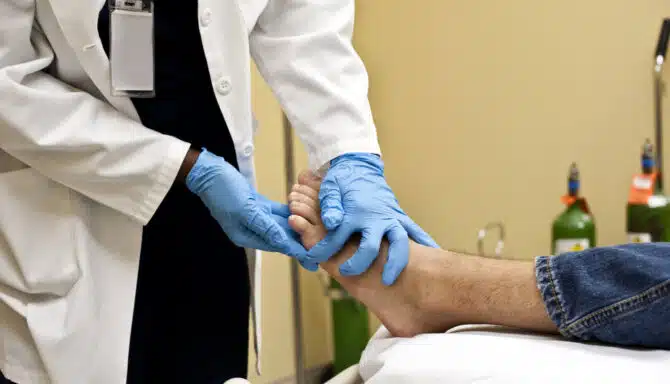March 27, 2025
Tight calves and foot health go hand in hand (or should we say foot in foot?). Our body parts are intricately connected, meaning discomfort in one area can lead to issues elsewhere. Likewise, muscle strain and fatigue in the lower legs can wreak havoc on the feet and other body parts if ignored for too long. Let’s explore the symptoms and causes of tight calves, how tight calves affect the body and feet, and how a chiropodist or podiatrist can help you manage pain.
Tight Calves: What Are They?
"Tight calves" is a general term describing the sensation of stiffness, pain and tension in the muscles at the back of the lower leg, often leading to restricted movement that affects your daily life. This tightness can manifest as muscle pain and stiffness when walking, balance issues, and more. Tight calves and posture even have a connection!
Anatomy of the Calf Muscles
The calf comprises two primary muscles:
Gastrocnemius: The primary or chief muscle in the calf. It’s located on the back of your leg, relatively close to the skin’s surface. This superficial muscle has two heads, medial and lateral. It helps flex the knee and foot, and also plays a crucial role in walking and posture.
Soleus: Located beneath the gastrocnemius, this wide and flat muscle is deeper, and originates from the posterior tibia while connecting to the Achilles tendon above the heel. This group helps stabilize ankle during activities like walking and running.
Understanding the structure and function of these may be helpful in determining the cause of calf muscle tension.
What Causes Calf Pain?
Pain in the lower part of the back of the legs does not always feel the same. It may come on suddenly, or nag at you all day by way of a mild, dull ache. The former is often the result of a sudden injury or sharp movement, whereas the latter can build over time, resulting from lifestyle choices like wearing unsupportive shoes or working out too hard.
Here are some common causes of calf pain:
Muscle Cramps. Sudden, involuntary contractions of the calf muscles, known as cramps, can cause significant tightness and discomfort. These cramps may result from factors such as dehydration, general muscle fatigue, or electrolyte imbalances.
Overuse. Engaging in repetitive activities that involve a lot of running or jumping can overwork the calf muscles and make them feel tight. This is especially common when increasing training intensity or duration without allowing yourself to rest.
Muscle Strain. Overstretching or tearing the calf muscles, often due to sudden movements or excessive force, can result in tightness, pain, and swelling.
Non-supportive and Ill-fitting Footwear. Shoes lacking arch support, shock absorption, or cushioning force the muscles to work harder with every step. Without proper arch support, the foot may put excessive strain on the calf muscles as they attempt to stabilize the lower leg. A lack of shock absorption further increases the impact of the ground on the feet and legs. Similarly, insufficient cushioning fails to distribute pressure evenly, leading to increased stress on the calves, especially during prolonged standing or walking.
Poor Ankle Mobility. Limited flexibility in the ankle joint can place additional strain on the calf muscles, contributing to tightness. Some causes include having a history of ankle injuries or arthritis.
Pre-existing Gait Abnormalities and Foot Type. Overpronation (excessive inward foot rolling — common in flat feet) or underpronation (excessive outward foot rolling — common with high arches), can lead to calf muscle tightness due to altered mechanics and increased strain.
Dehydration and Mineral Deficiencies. Lack of adequate fluids or essential minerals like potassium, magnesium, and calcium can lead to muscle cramps and tightness in the calves.
Inactivity. Prolonged periods of inactivity or sedentary behavior can cause the calf muscles to become tight due to lack of regular movement and stretching.
Venous Insufficiency. Conditions like deep vein thrombosis (DVT) or varicose veins can cause calf tightness, as well as general venous insufficiency.
How Tight Calves Affect the Body and Feet
We can feel the effects of tight calf muscles in more ways than one. Our feet can become weaker, more vulnerable and fatigued, sometimes leading to a foot condition we didn’t have before. Tight calves can also cause experience mysterious back and knee pain. Here are common additional problems can arise from strain in the lower legs.
Joint Pain
Tight calves can have a significant impact on the body's overall alignment, posture and movement, often leading to joint pain in the knees, back, and feet.
When the calf muscles are tight, they restrict proper ankle dorsiflexion (raising the foot upwards towards the shin). When ankle mobility is restricted, the body may lean forward slightly to maintain balance, causing strain on the lower back muscles and leading to chronic discomfort. This abnormality can put excessive strain on other joints, like in the knees. This perfect storm of joint problems and limited movement can contribute to conditions like osteoarthritis over time.
Biomechanical Foot Conditions
The feet often bear the brunt of tight calf muscles, as they have to absorb additional stress during movement. Calf pain can cause a disrupt our running or walking gait as we try to move through the pain. Further, since our calf muscles connect our knees to our ankles, when the calves become tight it puts strain on the ankle. This disrupts our foot mechanics and can cause painful, chronic overuse injuries like plantar fasciitis and Achilles tendonitis. In fact, tight calves is one of the leading contributing factors to Achilles tendonitis and plantar fasciitis.
Increased Risk of Injury
Aching, tense muscles are more susceptible to further strains and tears, in addition to also causing balance problems as you struggle with pain. All of this combined can be a recipe for disaster and lead to a slip or fall (especially in seniors) that may cause even more damage, like a broken bone. Tight calf muscles can also contribute to more mild conditions like shin splints (repetitive stress on the shin bone) and generally hinder athletic performance.
Circulatory Problems
The calf muscles assist in pumping blood back to the heart from the lower extremities. Tightness in these muscles can impede this process, resulting in swelling in the feet and ankles and, in severe cases, contributing to circulatory problems.
How to Treat Tight Calves: Muscle Tightness and Foot Care
https://www.youtube.com/shorts/sNdIAxZNOn8
A foot care professional can help with calf tightness and pain. With their guidance and your determination to improve your foot and leg health, you can live and move comfortably. Let’s explore some options.
Compression Stockings
Wearing medical-grade compression stockings can improve circulation in the lower legs, reducing muscle fatigue and tightness and giving your lower extremities a healthy, comforting and energizing boost.
They work by applying gentle pressure to the legs, which helps prevent blood pooling and promotes better oxygen delivery to the muscles. Compression therapy is especially useful for individuals who spend long hours on their feet, live a sedentary lifestyle, spend prolonged periods sitting while travelling, pregnant women, or those with conditions like varicose veins. A physician can determine the right level of compression based on your specific needs.
Custom Orthotics
Custom orthotics can help address underlying biomechanical issues that contribute to tight calves. A chiropodist can assess foot structure to design orthotics that conform to your feet, and yours alone, providing tailored support and alignment for your unique needs.
By correcting imbalances and reducing strain on the lower leg muscles, orthotics can help alleviate tightness and prevent further discomfort. These devices can be particularly beneficial for individuals with flat feet, high arches, or abnormal gait patterns that place excessive stress on the calves.
Proper Footwear
Shoes with adequate arch support, cushioning, and shock absorption that redistributes pressure away from the heel can help keep your feet comfortable, maintain proper lower limb alignment and reduce strain on the calf muscles. Chiropodists and podiatrists often advise against wearing unsupportive footwear like flip-flops or high heels for prolonged periods, as they can contribute to muscle tightness and discomfort in the calves and feet.
Strengthening Exercises and Stretching Programs
A structured exercise program focusing on calf flexibility and strength can significantly reduce tightness. Chiropodists can recommend targeted stretches that target the gastrocnemius and soleus muscles — helping improve range of motion in the lower leg and fighting off stiffness.
Calf raises in particular (see demonstration below) can enhance muscle endurance and prevent recurring tightness. Incorporating these exercises into a daily routine can improve mobility and reduce the likelihood of calf-related discomfort.
Some other good examples of stretches for calf muscles include the Soleus Stretch and Heel Stands. Click the links for Feet First Clinic demonstrations!
https://www.youtube.com/shorts/ZVSfzY6so8w

